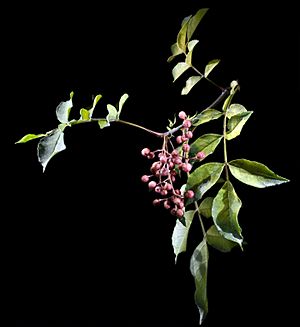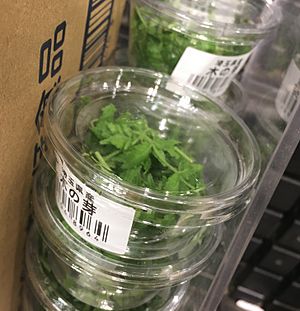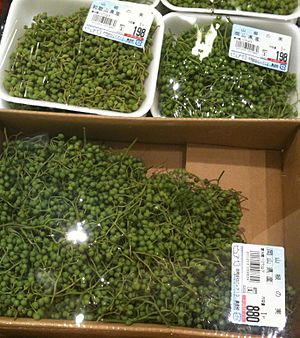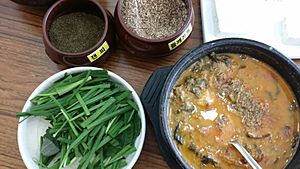Japanese pepper facts for kids
Quick facts for kids Japanese pepper |
|
|---|---|
 |
|
| Scientific classification | |
| Genus: |
Zanthoxylum
|
| Species: |
piperitum
|
Zanthoxylum piperitum, also known as Japanese pepper or Japanese prickly-ash, is a special plant. It is a type of shrub or small tree that loses its leaves in winter. It belongs to the citrus and rue family. This plant is originally from Japan and Korea.
Both its leaves and fruits are used to add a unique flavor to food in these countries. It is related to the Chinese Sichuan peppers, which come from similar plants.
Contents
What It's Called
In Japan, Z. piperitum is called sanshō (山椒). This means "mountain pepper."
In Korea, this plant is called chopi (초피). Some people also call it "Korean pepper." In certain areas of Korea, like Gyeongsang, it might also be called sancho or jepi (제피). The name "Japanese prickly-ash" is also used, especially in America.
Different Types
There are different types, or varieties, of Japanese pepper. One type is called Z. piperitum var. inerme. In Japan, it's known as "Asakura zanshō." This type has very few or no thorns, making it easier to grow and harvest.
Another type is called Z. piperitum f. pubsescens. In Korea, it's known as teol chopi (털초피), which means "hairy chopi."
Where It Grows
This plant naturally grows in many places. You can find it from Hokkaido to Kyushu in Japan. It also grows in the southern parts of the Korean peninsula. You can even find it in mainland China.
What It Looks Like
The Japanese pepper plant is part of the citrus and rue family.
The tree blooms in April or May. It grows small, yellow-green flowers, about 5mm wide. Some plants have male flowers, and others have female flowers. This means it is dioecious. The male flowers can be eaten as hana-sanshō. The female flowers grow into small berries, or peppercorns, about 5mm in size.
In autumn, these berries turn bright red and then burst open. This releases the black seeds inside.
The branches of the plant have sharp thorns that grow in pairs. Its leaves are made up of 5 to 9 pairs of smaller leaflets. These leaflets are oval-shaped and have slightly jagged edges.
This plant is also a host for the citrus butterfly, Papilio xuthus. This butterfly is native to Japan and has also spread to Hawaii.
How It's Grown
In Japan, Wakayama Prefecture grows a lot of Japanese pepper. About 80% of Japan's domestic production comes from this area. A special type called budō sanshō is grown in Aridagawa, Wakayama. It has large fruits that grow in clusters, like grapes.
The thornless type, Asakura sansho, gets its name from where it was first grown. This was in the Asakura area of Japan.
How It's Used
In Cooking
Japanese pepper is related to the Sichuan pepper from China. Both plants are from the same family and are used to add flavor to food.
Japanese Food
The dried and ground-up fruits are called "Japanese pepper" or kona-zanshō (粉ざんしょう). This is a common spice sprinkled on grilled eel, called kabayaki-unagi. It is also one of the seven main ingredients in a mixed spice called shichimi. This blend also includes red chili peppers. You can often find kona-zanshō sold in small packets.

The young leaves and shoots are called ki-no-mé or ko-no-mé (木の芽). They are a sign of spring and are often used to decorate grilled fish and soups. They have a unique taste that some people really enjoy. It's a tradition to clap your hands with a leaf between them. This is said to release the leaf's fresh smell.
These young leaves can also be crushed and mixed with miso paste. This creates a sauce, similar to pesto. This sauce is then used in various tossed salads called aemono. It's often mixed with fresh bamboo shoots. But it can also be used with sashimi (raw fish), clams, squid, or other vegetables.
The young, green berries are called ao-zanshō (lit. green sansho). These can be quickly boiled and salted. Or, they can be cooked in soy sauce to make a dark-brown condiment called tsukudani. The berries are also sold simply soaked in soy sauce. Sometimes, the berries are cooked with small fish and soy sauce. This is a special dish from Kyoto, especially from the area around Mount Kurama, where the plant grows well.
There is also a sweet treat called kirisanshō. It is a rice cake dessert flavored with ground Japanese pepper. This is a popular food in northern Japan.
In central and northeastern Japan, a grilled rice cake called goheimochi sometimes uses Japanese pepper. It's added to the miso paste that covers the rice cake. You can also find sansho-flavored rice crackers and sweet sansho-mochi snacks.
Korean Food
In southern Korea, the plant and its fruit are called chopi (초피). People in different areas might also call it jepi (제피), jenpi (젠피), jipi (지피), or jopi (조피). This plant is widely grown and eaten in these regions.
Long ago, before chili peppers came to Korea, people used a paste spiced with chopi and black peppers.
Today, in southern Korean cooking, dried and ground chopi fruit is used as a spice. It's often served with dishes like chueo-tang (loach soup), maeun-tang (spicy fish stew), and hoe (raw fish).
The young leaves, called chopi-sun (초피순), are used as a cooking herb or a vegetable called namul. The leaves are also pickled as jangajji. They can be pan-fried to make a pancake called buchimgae, or deep-fried as fritters like twigak and bugak. Sometimes, chopi leaves are added to a mixture of anchovy and salt to make a special fish sauce.
Craftwork
In Japan, the strong wood of the Japanese pepper tree is traditionally used to make a special pestle. This pestle, called surikogi, is used with a grinding bowl called suribachi. Even though these wooden pestles are less common now, they can add a subtle flavor to the foods you grind with them.
Traditional Medicine
In Japan, the dried outer husks of the fruit (without the seeds) are used in some traditional medicines. They are an ingredient in certain bitter tinctures and in toso wine, which is served during ceremonies.
Fishing
In southern parts of Korea, the fruit of the Japanese pepper plant is traditionally used in fishing. If a few fruits are dropped into a pond, they can make small fish float to the surface shortly after. This is because the fruit is poisonous to small fish.
Error: no page names specified (help). In Spanish: Zanthoxylum piperitum para niños
In Spanish: Zanthoxylum piperitum para niños




